


|

|
|
|
|
Building Conditions and Queries in the BEA E-Business Control Center
This topic is a central point of reference for information about building conditions and queries in the BEA E-Business Control Center. The sections in this topic are not meant to be read in sequence, but rather, are pieces of information or instructions that you will use in the context of other tasks. These tasks may be used when defining customer segments, running a query for content selectors, or adding scenarios to your promotional campaigns. (Queries search your content management system for documents based on a set of criteria that you specify.)
This topic includes the following sections:
Listing of the Available Conditions
The E-Business Control Center provides you with a number of conditions you can use to customize your e-marketing efforts. Depending on what you are trying to accomplish in the E-Business Control Center, you may encounter some or all of the conditions described in Table 3-1.
Using the Select Customer Segments Window
When you click the [customer segment] hyperlink, the Select Customer Segments window opens. Figure 3-1 shows the Select Customer Segments window.
Figure 3-1 Select Customer Segments Window
Note: If you make a mistake, click a customer segment name shown in the Selected Segments list to select it, then click Remove.
Using the Properties and Property Values Windows
Many items in the E-Business Control Center can be described by their characteristics or properties. For example, visitors to the site, content to be shown to visitors, and events that represent visitor behavior can all be described in terms of their properties. Related properties are grouped together for convenience into property sets. Objects in the E-Business Control Center may have one or more property sets associated with them. For example, visitors may have one set of properties pertaining to general information, such as their address, and another set of properties pertaining to demographic information, such as their gender.
The windows where you describe E-Business Control Center objects by way of their properties are generically referred to as Properties windows. Using the Properties windows, and their associated Property Values windows, you can build Descriptors that describe an object of interest. The Descriptor is comprised of a property phrase and a value phrase.
For example, you may be interested in targeting an e-mail to customers whose income range is $75,000-$99,000. The Descriptor created in an E-Business Control Center Properties window would be:
Demographics: Income_Range is equal to "$75,000-$99,000."
Demographics is the property set in which you would find the Income_Range property, Is Equal is the comparison, and "$75,000=$99,000" is the value. Together, the property set and property form the following Property Phrase:
Demographics: Income_Range
Together, the comparison and the value form the following Value Phrase:
is equal to "$75,000-$99,000."
When you click the [characteristics] or [properties] hyperlinks, a Properties window opens. Figure 3-2 is an example of a Properties window.
Figure 3-2 Properties Window
Note: The E-Business Control Center includes some values for the Property Set and Property lists. However, additional Property Sets and Properties may be defined by your organization's Commerce Business Engineer (CBE) or other technical resource.
Figure 3-3 Property-Values Window
Warning: It may be possible to construct value phrases that are not reasonable in real world situations. Be sure to select a comparison and value that makes sense for the property set and property you previously selected. Figure 3-4 Value Phrases List Box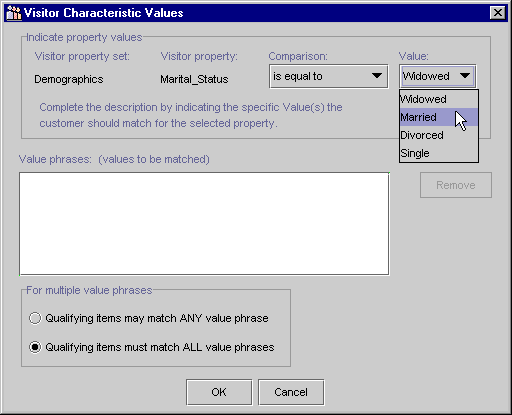
Note: If you need to remove a value phrases, click on the value phrases in the Value Phrases list box to select it, then click Remove. Figure 3-5 Descriptors List Box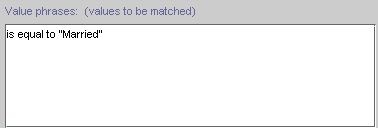
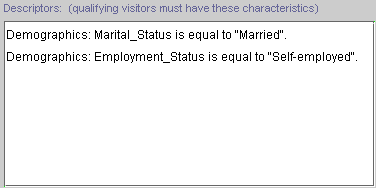
Using the Select Events Window
When you click the [event name] hyperlink, the Select Events window opens. Figure 3-6 shows the Select Events window.
Figure 3-6 Select Events Window
Note: If you make a mistake, click an event name shown in the Selected Events list to select it, then click Remove.
Using the Date/Time Entry Dialog Boxes
When you click one of the generic date or time related hyperlinks, one of the date/time entry dialog boxes opens. Simply type in the date and/or time in the appropriate field, then click OK. When you do so, the date/time entry dialog box closes, and the generic hyperlinks change to reflect the dates and/or times you specified.
Tip: For dates, you can either type in the date, or click the drop-down calendar to select the date, as shown in Figure 3-7. Just click a date to select it.
Figure 3-7 Date Calendar
Using the Quantity Selector or Currency Selector Dialog Boxes
When you click the [n] hyperlink, a Quantity Selector dialog box opens. When you click the [monetary amount] hyperlink, a similar dialog box, called Currency Selector opens. Figure 3-8 shows the Quantity Selector dialog box.
Figure 3-8 Quantity Selector Dialog Box
Note: A default value may be shown in the field.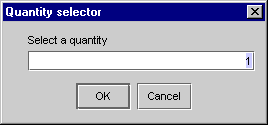
Using the Select Operator Dialog Box
When you click the Equal To hyperlink, a Select Operator dialog box opens. Figure 3-9 shows the Select Operator dialog box.
Figure 3-9 Select Operator Dialog Box
Note: A default value of Is Equal To is highlighted, which is why the hyperlinked Equal To text you clicked on to open the dialog box was not enclosed in brackets.
Using the Enter SKU Numbers or Enter Categories Windows
When you click the [sku] hyperlink, an Enter SKU Numbers window opens. When you click the [product category] hyperlink, a similar window, called Enter Categories opens. Figure 3-10 shows the Enter SKU Numbers window.
Figure 3-10 Enter SKU Numbers Window
Note: Be sure you obtain the exact SKU number or product category from those who maintain your product catalog and that you enter them correctly.
Note: If you make a mistake, click the SKU number or product category in the list to select it, then click Remove.
So, for example, if you specified SKU number T144 and SKU number D128 and you selected the Any option, customers with either of these SKU numbers in their shopping cart would meet the conditions. If you selected the All option, customers with both of these SKU numbers in their shopping cart would meet the conditions.
Using the Enter a Range Dialog Box
When you click the [x] or [y] hyperlinks, the Enter a Range dialog box (shown in Figure 3-11) opens.
Figure 3-11 Enter a Range Dialog Box
Constructing Queries
To create ad placeholders, scenario actions, and content selectors that find and display documents, you must construct queries. Queries search your content management system for documents that you describe. You can describe documents in the following ways:
For example, you want to display ads for ACME mutual funds in an ad placeholder. Your content management system uses a property named productName to indicate the name of the mutual fund that a document advertises. You construct a query that finds all documents for which the productName property contains ACME.
For example, you want a content selector to display documents that describe investing in mutual funds. Your content management system uses a document property called investorRiskLevel to identify whether a document describes an investment that is aggressive, moderate, or conservative. Your customer profiles also include a property called investorRiskLevel to indicate whether a customer prefers aggressive, moderate, or conservative investments. You construct a query that finds all documents for which the investorRiskLevel property contains a value that is equal to the value of a customer's investorRiskLevel property.
For content selectors and scenario actions, you can also combine the two types of descriptors in a single query. For example, you can create a query for a content selector that finds documents that advertise ACME mutual funds and that match a customer's investment-risk profile.
To construct queries, do the following:
You can search for multiple document properties by repeating steps 1 through 3.
Select a Document Property
You select document properties in the Ad Search window or the Content Search window, depending on whether you are creating an ad placeholder, scenario action, or content selector. The E-Business Control Center displays the Ad/Content Search window when you do any of the following:
In the Ad/Content Search window, do the following:
For example, you are constructing a query for an ad placeholder. Your content management system uses a property named productName to indicate the name of the product that a document advertises. To search for an ad based on the name of the product it advertises, click productName from the Property list.
Figure 3-12 Select a Property for an Ad Placeholder
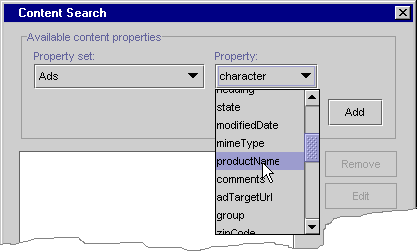
Describe Documents by Comparing the Property to a Value or Range of Values
To find documents by comparing the document property with a value or range of values, do the following:
For example, to find documents in your content management system that advertise ACME products, select Is Equal To from the Comparison list. Then enter ACME in the Value list.
Figure 3-13 The Values Tab for Content-Selector Queries
Describe Documents by Comparing the Property with the Properties of Other Objects
If you are constructing a query for a scenario action or a content selector, you can find documents by comparing the document property with the properties of other objects. To construct such a query, do the following:
If you are constructing a query for a scenario action, you can compare the document property with a user, session, request, or event property.
If you are constructing a query for a content selector, you can compare the document property with a user, session, or request property.
For example, you created a document property called investorRiskLevel to identify whether a document describes an investment that is aggressive, moderate, or conservative. Your customer profiles also include a property called investorRiskLevel to indicate whether a customer prefers aggressive, moderate, or conservative investments. To create a content selector query that matches documents with a customer's investment-risk preference, in the Content Search window, you select the investorRiskLevel document property. In the Content Search Values window, you click the Properties tab. From the Comparison list, select Is Equal To. Then from the Property Set Type list, select User. (See Figure 3-14.)
For example, if you place the investorRiskLevel user property in a property set named InvestmentProfile, then choose InvestmentProfile from the Property Set list.
Figure 3-14 Find Documents by Comparing the Properties of a User
Specify How to Handle Multiple Value Phrases and Descriptors
Preview the Query Results
To run the query and see the documents that it finds, do the following:
The E-Business Control Center prompts you for a user ID.
For example, you want to see the documents that the query returns for customers with a conservative investment profile. The customer profile for Pat Gomes specifies a conservative investment profile, so you enter Pat's ID.
Note: You must enter a user ID, regardless of the type of condition that activates a placeholder, scenario action, or content selector.
The E-Business Control Center runs the query and displays the results in your default browser. (See Figure 3-15.)
The top pane displays the query and the left pane displays the names of the ads that the query finds.
The right pane of your browser displays the document.
Note: WebLogic Commerce Server and Personalization Server create a short-lived cache that stores the results of a query. If you add or modify documents in your content management system and then immediately redo the query preview, you might not see the results of your modifications. If this occurs, wait several minutes and then retry the query preview.
Figure 3-15 Query Preview in the Browser
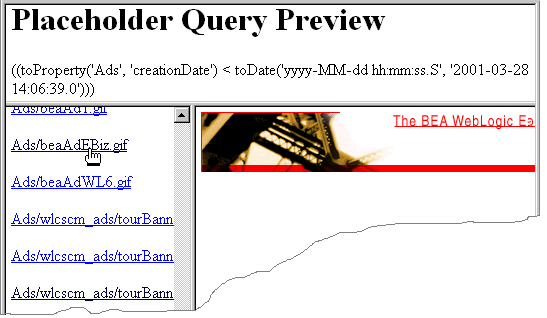

|

|

|
|
|
|
Copyright © 2001 BEA Systems, Inc. All rights reserved.
|